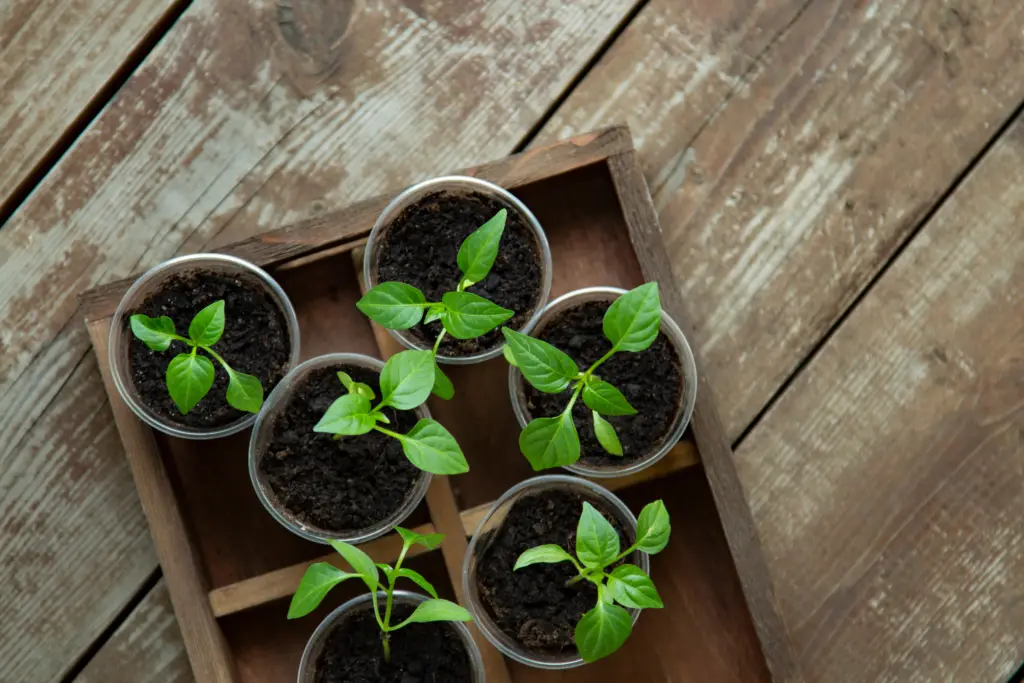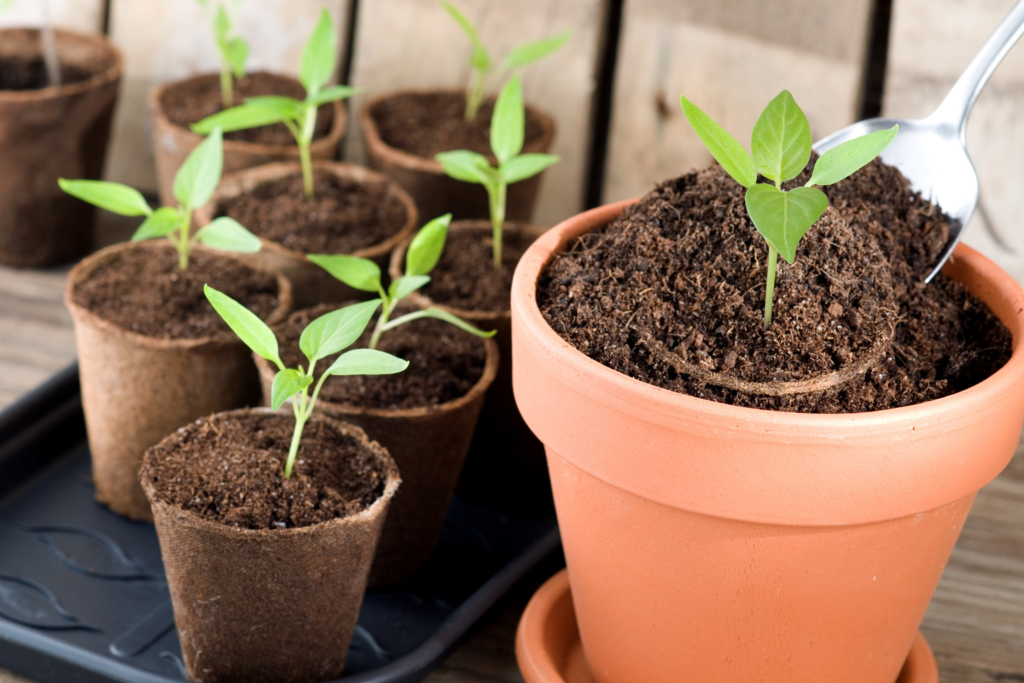Whether you want to diversify your garden or are dealing with limited space, pots and containers can be your greatest allies. Growing bell peppers in pots might require some knowledge, but once you master the fundamentals, you can look forward to a generous harvest!
When growing bell peppers in containers or pots, it’s crucial to use a pot that’s at least 3 gallons in size. Ideally, place the container in full sun. Use well-draining soil and fertilize upon planting, then apply a controlled-release fertilizer throughout the season. Pots tend to dry out quickly, so using mulch to retain moisture can be helpful.
Read on to unearth tips and strategies on how to cultivate your own bell peppers in pots or containers!
Is it okay to grow bell peppers in pots or containers?
First, let’s address the question of whether bell peppers can thrive in pots.
You can grow bell peppers in pots or containers, and this is an excellent option if you’re short on space or want to add some color to your garden. A pot that’s at least 3 gallons large is suitable. Bell peppers grow best in well-drained soil and do well in pots as they allow excess water to drain away. One potential problem is your pepper becoming rootbound.
Adding variety to your garden is a great way to enhance its aesthetic appeal. Potted plants add a unique touch and character to your personal green space!
If you live in an apartment with a balcony or a small patio, potted plants can be a godsend. Using pots allows you to engage in gardening even when you’re short on space.
Luckily, the versatile bell pepper thrives in pots or containers! With a proper understanding of your pepper plant’s needs, your bell peppers can grow tall and provide a plentiful supply of peppers!

Potential benefits of growing bell peppers in pots or containers
Numerous reasons might inspire gardeners to grow their bell peppers in pots or containers.
The potential benefits of growing bell peppers in pots or containers include:
- Space – You can grow bell peppers even if you’re short on space. Container growing is the only option for some people, allowing those with limited space to still enjoy gardening.
- Environmental control – You can bring your bell peppers indoors in extreme weather, protecting them from hurricanes, frost, or other extreme conditions.
- Drainage – Bell peppers love well-draining soil, which is easier to achieve in pots than in the ground or even in raised beds.
- Pest control – Potted plants generally encounter fewer pests than plants grown in the ground. Using fresh potting soil and elevating your plants away from pests can provide an extra layer of protection.
- Soil control – Peppers prefer a soil pH of 6.0-6.5. While you can amend ground soil to reach the desired pH, using ready-to-go soil is often easier.
Potential issues growing bell peppers in pots or containers
While bell peppers usually do well in pots, there are some challenges worth discussing.
Potential issues with growing bell peppers in pots or containers include:
- Size requirements – You’ll need a relatively large container – at least 3 gallons. Bell peppers can reach 3-4 feet tall and need room for root systems to support all that growth.
- Space – Growing space will be limited compared to growing in the ground or in raised beds.
- Attention – Your bell peppers may not reach their full potential if you’re not attentive. Plants growing in pots can get rootbound, stunting their growth and possibly reducing yield.
- Environmental control – Plants grown in pots need to be watered more frequently due to quicker soil drying.
With these potential pros and cons in mind, let’s explore some of the best tips for growing bell peppers in pots and containers.

10 Tips for Growing Bell Peppers in Pots or Containers
To help you cultivate your peppers successfully, here are my top five tips for growing bell peppers in pots or containers:
- Choose the right soil and fertilizer
- Ensure your pot is large enough
- Position your pots in the sun
- Balance quick drainage with adequate moisture
- Prevent your bell peppers from becoming rootbound
- Select the Right Variety of Bell Pepper
- Optimal Temperature
- Pollination
- Pruning and Pinching
- Support the Plants
Now let’s delve into each of these tips!
Choose the right soil and fertilizer
Bell peppers thrive in well-draining soil with a pH between 6.5 and 7. To create an optimal environment, use a high-quality potting mix that allows adequate air circulation and water drainage. Avoid garden soil, as it tends to be too heavy and might contain pests or diseases.
As for fertilizer, use a balanced blend (like a 10-10-10) at planting time. Once the plant begins flowering, switch to a low nitrogen, high potassium, and phosphorus fertilizer to encourage fruiting. Remember, over-fertilization may cause excessive foliage at the expense of fruit production, so moderation is key.
Ensure your pot is large enough
What is the best container size for bell peppers?
Bell peppers need room to grow. Using pots or containers that are at least 3 gallons in size will ensure the roots have enough space to expand and gather nutrients. A pot of this size can also accommodate the 3-4 foot height the pepper plant might reach. If your plant appears stunted or the roots are growing out of the drainage holes, consider upgrading to a larger pot.

Position your pots in the sun
Bell peppers are sun-lovers and need at least 6-8 hours of sunlight each day to produce a bountiful harvest. Position your pots where they can get consistent and direct sunlight throughout the day. If you’re growing peppers indoors, place them near a south-facing window or supplement natural light with grow lights.
Balance quick drainage with adequate moisture
While bell peppers prefer well-draining soil, they also need consistent moisture to thrive. As pots and containers tend to dry out quickly, it’s essential to water your peppers regularly.
However, avoid overwatering, as this can lead to root rot. An excellent method to balance drainage and moisture retention is to apply organic mulch around the base of the plant. Mulch helps keep the soil cool and slows the evaporation of water.

Prevent your bell peppers from becoming rootbound
Becoming rootbound is a common issue with plants grown in pots or containers. This happens when the roots take up the entire pot, leaving no room for expansion. It can stunt the plant’s growth and decrease yield. Regularly inspect your pots. If roots begin to circle around the pot or grow through the drainage holes, consider repotting into a larger container.
Do bell peppers grow better in pots or in the ground?
All things considered, they should do well in both!
Select the Right Variety of Bell Pepper
Not all bell peppers are created equal, especially when it comes to growing them in containers.
Some varieties are more suited to container growth due to their smaller size and more compact growth habit. Varieties like ‘Mini Bell Mix’ or ‘Baby Bell’ are smaller but still deliver an abundant harvest. These dwarf or mini bell pepper plants require less space to grow, making them ideal for container cultivation. They also mature quicker, meaning you can enjoy your harvest sooner.

Optimal Temperature
Bell peppers are sensitive to temperature and thrive best between 70°F and 85°F. Temperatures below 60°F can slow their growth, while temperatures above 90°F can cause the plants to become stressed and drop their blossoms, negatively impacting fruit production.
If you’re starting your seeds indoors and live in a cooler climate, consider using a seedling heating mat to help maintain optimal soil temperature for germination. If you live in a hotter climate, you may need to provide some shade for your plants during the peak afternoon heat to prevent them from becoming heat stressed.
Pollination
While bell peppers are self-pollinating, which means they don’t require another plant to produce fruit, they can sometimes struggle with pollination, particularly when grown indoors or in sheltered outdoor locations with little wind.
To assist, you can manually pollinate your plants by gently shaking them to dislodge the pollen within the flowers or using a small, soft brush or cotton swab to transfer pollen from one flower to another. This can help ensure a good fruit set.
Pruning and Pinching
Pruning and pinching are techniques that can help your bell pepper plants grow bushier and more productive. When your plant is about a foot tall, pinching off the top of the plant can encourage it to branch out, leading to two main stems and potentially a greater yield.
Regularly check your plants for any yellowing or diseased leaves and remove them promptly. This not only keeps the plant healthy but also helps prevent the spread of diseases and pests.

Support the Plants
Bell pepper plants, especially those bearing a heavy load of fruit, can become top-heavy. To prevent branches from breaking under the weight, consider staking your plants or using small cages for support.
It’s important to install any support structures early in the plant’s life to minimize the risk of damaging the roots. This can be as simple as a stake or bamboo stick pushed gently into the soil, or a specially designed cage placed over the plant.
As the plant grows, you can tie it to the support structure using soft ties to prevent any damage to the stems.
By following these detailed tips, you’re setting yourself up for a successful bell pepper harvest. Remember, patience is key in gardening – with time and care, your bell peppers will be ready to spice up your meals before you know it!
